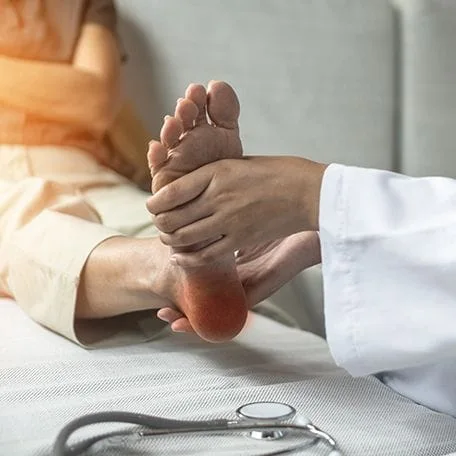
What is Heel Pain?
The calcaneus, or heel bone as it's commonly referred to, is the largest of the 26 bones that make up the foot. Heel pain can occur in the bottom, front, or back of the heel. This swelling, tenderness, and sometimes acute pain can be caused due to many different reasons such as overuse of the heel, running on hard surfaces such as concrete, or bursitis.
Some patients experience mild but chronic heel pain, which is manageable. However, for others, as in the case of patients with fractures, it might be debilitating. Regular checkups of your feet by a podiatrist is highly recommended for preventing heel pain.
What Are the Causes of Heel Pain?
As previously mentioned, patients experience heel pain for a variety of reasons. Injury, Plantar fasciitis, improperly fitted shoes, and overuse during physical activity are some of the main reasons why heel pain occurs. Patients with certain diseases, such as gout and rheumatoid arthritis, may also experience heel pain.
Other reasons heel pain can occur are:
- tightness in the calf and Achilles tendon
- landing hard on the heel
- heel spurs
- heel fractures
- calcaneal apophysitis—irritation of the center of the heel bone
- Haglund's deformity
- pinched nerve
What Are the Symptoms of Heel Pain?
Symptoms of heel pain include:
- tenders and swelling
- swelling of the fluid-filled sacs, bursae, around the heel
- redness
- numbness
- tingling
What to Expect During Treatment for Heel Pain at the Podiatrist
As heel pain can occur for several different reasons, a podiatric appointment will help determine the cause and severity of your heel pain, as well as provide a personalized treatment plan that best works for you. Patients with diabetes and peripheral neuropathy should always schedule regular podiatric appointments to ensure optimal wellness.
Your podiatric physician will begin by asking a comprehensive set of questions to determine your medical history, lifestyle, foot symptoms, and any recent trauma or injuries. From there, the following exams will be carried out: physical foot exam—your podiatrist will compare both feet, look for the presence of any deformities, tenderness, discoloration, or decreased range of motion.
- gait evaluation—to evaluate how you walk, your overall posture and how you bear weight on your feet
- neurological exam—indicates the presence of nerve damage
- shoe exam—determines your regular footwear, including running gear
- X-rays and other diagnostic tests
Treatment of your heel pain will depend on the severity of your symptoms and the cause. Patients can expect to feel better between 6 to 8 weeks of regular therapy. It can include:
- rest and elevating your feet
- use of NSAIDs to treat inflammation and swelling
- shoe supports, heel pads, and cushions
- use of crutches to take the weight off your feet
- cortisone injections
- physical therapy
- stretching of calves, ankles, and feet
- surgery—only a last case resort if all other forms of treatment have failed.
